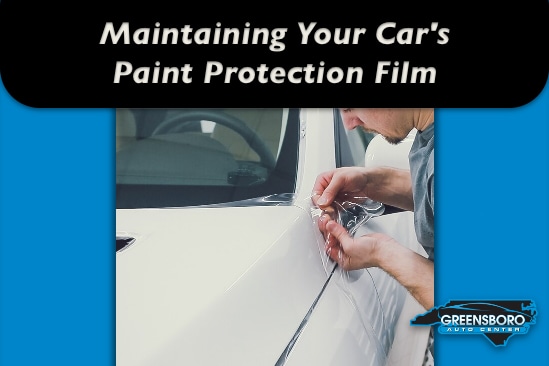
Paint protection film is an excellent way to protect your vehicle’s paint from the harsh elements of the road, weather, and sun, but like any premium product, proper maintenance is required. Today, let’s take a look at how to keep our car’s PPF barrier looking good and doing its job with some basic tips, and especially what to avoid.
The Bottom Line: Gentle Washing
The most important aspect of PPF maintenance is proper washing. Though this barrier is made to absorb damage and abrasions, you’ll want to avoid being one of those elements, so no rough materials or harsh chemicals.
- Hand Washing is Best: We highly recommend hand washing your vehicle with a high-quality, pH-neutral car soap and the two-bucket method (one bucket for soapy water, one for rinsing your wash mitt). This minimizes the risk of introducing swirl marks or contaminants.
- Soft Wash Mitts & Microfiber Towels: Always use a soft, clean microfiber wash mitt and plush microfiber drying towels.
- Rinse Thoroughly: Before washing, rinse your car thoroughly to remove loose dirt and debris. After washing, rinse equally well to ensure no soap residue is left behind.
- Avoid Pressure Washers: While you can use a pressure washer, the edges and seams of your film are what’s most at risk here. Too much pressure at a bad angle can begin lifting the film.
- No Wax with Naphtha or Kerosene: Traditional car waxes containing petroleum distillates like naphtha or kerosene can degrade the film over time, leading to yellowing or hazing, so be sure to do your research before application.
- Avoid Abrasive Polishes or Compounds: Agin, we know PPF is tough stuff, but using rubbing compounds, abrasive polishes, or harsh chemical cleaners will damage the self-healing layer and clarity of the film.
- Steer Clear of Solvents: Bug and tar removers, degreasers, or any products containing harsh solvents can stain or damage the film. If you encounter stubborn spots, try a gentle car wash soap solution or a dedicated PPF-safe cleaner.
Stain Removal & Spot Cleaning
Despite your best efforts, sometimes your car will pick up stubborn stains, and this is where it can become easy to get overly aggressive. Before rubbing a hole through your film, try the following:
- Fresh is Best: Address bug splatter, bird droppings, and tree sap as soon as possible. The longer they sit, the harder they are to remove and the higher the chance of staining.
- Geeeeently Now: For stubborn spots, try a dedicated, pH-neutral car wash soap solution or a specific PPF-safe cleaner. Apply with a soft microfiber cloth and let it dwell for a moment before gently wiping away. Do your best to avoid scrubbing aggressively.
Enhance & Protect with PPF-Specific Toppers
While PPF doesn't need waxing, applying a high-quality, PPF-compatible sealant or ceramic coating can enhance its appearance and make maintenance even easier.
- PPF Sealants: These products are specifically designed to be compatible with PPF. They add an extra layer of slickness, enhance gloss, and provide additional UV protection, making the film easier to clean and more resistant to contaminants.
- Ceramic Coatings for PPF: Many detailers (us included) now offer ceramic coatings specifically formulated for paint protection film. These coatings bond to the film, offering superior hydrophobic properties (water beading), increased scratch resistance (to the coating itself), and extended durability. This is an excellent option for those seeking the ultimate in protection and ease of maintenance.
Regular Inspections
Periodically inspect your PPF for any signs of damage or wear.
- Check Edges: Pay close attention to the edges and seams of the film. If you notice any lifting or peeling, contact your installer promptly. Early intervention can often prevent further issues.
- Look for Contaminants: A quick visual check can help you identify and address any new contaminants before they have a chance to set in.
Professional Care (When Needed)
While DIY maintenance is straightforward, there are times when professional help is beneficial.
- Deep Cleaning or Decontamination: If your film feels rough or appears to have embedded contaminants that you can't remove, a professional detailer can perform a gentle decontamination without damaging the PPF.
- PPF-Specific Ceramic Coating Application: Applying a ceramic coating to PPF is often best left to experienced professionals to ensure proper bonding and an even finish.
Enjoy Your Protected Ride!
Maintaining your paint protection film is a small effort that yields significant rewards. By following these simple steps, you'll ensure your investment continues to protect your vehicle's paint, keeping it looking pristine and preserving its beauty for years to come. If you have any questions about specific products or advanced care, don’t hesitate to reach out to us!